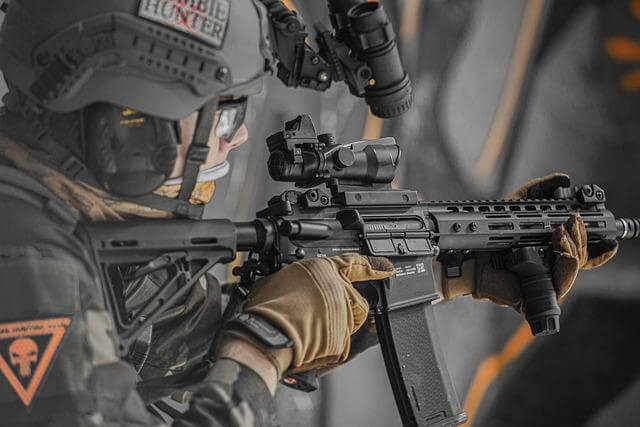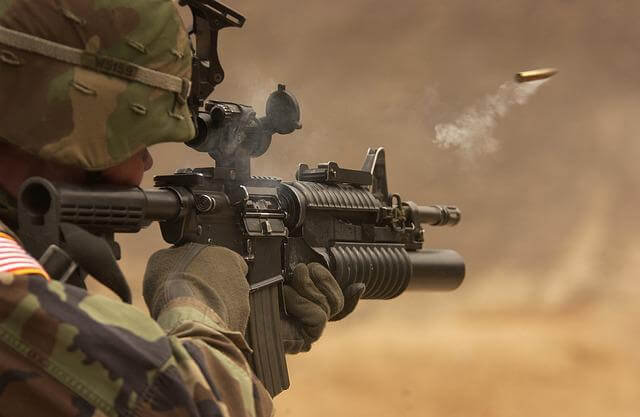This site contains affiliate links. As an Amazon Associate, I earn a commission from qualifying purchases at no extra cost to you. Full Disclosure Here.
Zeroing a red dot sight correctly is one of the fastest ways to improve accuracy and confidence with any firearm. Whether you’re mounting a red dot on a pistol, rifle, or shotgun, this guide explains how to sight it in properly—at home or at the range—using proven methods from both civilian and military experience.
Safety First
- Treat every firearm as loaded.
- Unload completely before sighting or inserting any tool into the bore.
- Keep the muzzle pointed in a safe direction at all times.
- Use a secure rest and a safe backstop for live-fire confirmation.
- Wear eye and ear protection.
Tools & Setup
Before zeroing, gather a few essentials to make the process quick, repeatable, and safe:
- Bore-sight or laser sighter: Helps align your optic before firing a shot. Our red-dot guide lists several compatible models.
- Solid rest or shooting bags: Stability is everything—small movements mean big misses downrange.
- Targets with 1-inch grids: Simplify MOA adjustments and see group placement clearly.
- Torque wrench & thread locker: Keeps mounts consistent between sessions.
- Notebook or phone app: Record clicks and offsets; data helps you diagnose drift later.
Good prep saves time and ammunition. The cleaner your mount and setup, the easier your zero will hold.
Core Concepts
POA (Point of Aim) is where your dot is placed. POI (Point of Impact) is where the projectile actually lands. Your goal in zeroing is to make POA and POI match at a chosen distance.

Adjustment Directions
- Shots left → adjust windage right.
- Shots right → adjust left.
- Shots low → adjust elevation up.
- Shots high → adjust down.
Most optics mark their turrets with arrows showing which way the point of impact moves—always turn toward the direction you want hits to go.
Choosing a Zero Distance
- Pistols: 10–25 yards
- AR Pistols: 25–50 yards
- Rifles / Carbines: 50 or 100 yards
- Shotguns (Slugs): 25–50 yards
Consistency matters more than the exact number. Pick one zero distance, memorize its holdovers, and build your muscle memory around it.
Rifles

Standard 50–100 Yard Zero
Start by bore-sighting at 25–50 yards to get on paper, then confirm with live fire at your chosen distance. Many shooters prefer 50 yards for carbines or 100 yards for precision rifles. Adjust per click math until your point of aim and impact coincide. Adding a magnifier can help fine-tune at distance without changing your primary zero.
25-Meter Zero (Military Method)
In the Army I was taught the 25-meter zero and still use it today. With 5.56×45 mm NATO ammunition, a sight height of ~2.6 inches, and standard ballistics, the bullet crosses the line of sight at 25 m and again near 300 m. The result is a simple “center-mass hold” that keeps you within a few inches of true point of aim from muzzle to 300 m.

- Distance: 25 m initial ≈ 300 m secondary zero
- Hold: Slightly high (~2 in) around 150 m, slightly low (~6 in) past 350 m
- Purpose: Fast, combat-effective trajectory without holdovers inside 300 m
If your range uses yards, zero at 25 yards—close enough for identical results. Combine this method with a modern red dot from our best red-dot sight roundup and you’ll have a dependable do-all setup.
AR-15 Pistol Zero
Shorter barrels produce lower velocity and more drop. A 25–50 yard zero balances close-range speed with mid-range precision. Maintain a consistent cheek weld and confirm holds past 50 yards if you shoot longer ranges.
Pistols
Handguns benefit from shorter zero distances. Ten to twenty-five yards works for most red-dot-equipped pistols used in competition, carry, or duty roles.
- Rest the pistol on bags or a stable surface to remove hand wobble.
- Fire a 3–5 shot group at your target distance.
- Measure offset and adjust using the direction rule.
- Confirm with another group and lock your adjustments.
How to Aim with a Pistol Red Dot
- Keep both eyes open to retain peripheral vision.
- Focus on the target, not the dot—the dot will appear on the same focal plane.
- Adjust brightness so the dot is crisp, not flared.
- Use a consistent grip and presentation; dry-fire builds muscle memory.
Shotguns
Shotguns are unique because pattern shape matters as much as point of impact. If you’re running a dedicated red dot for turkey hunting or slug work, check our best red dots for shotguns guide for mounting tips and optic options.
How to Zero a Red Dot on a Shotgun
For slugs, treat your shotgun like a rifle: mount the optic securely, start at 25 yards, bore-sight if possible, then fire three shots and adjust. For buckshot or birdshot, pattern testing is more important than exact zeroing.
- Use the same choke and load you plan to hunt with.
- Pattern at 20, 30, and 40 yards to see where pellets center.
- Adjust the dot so the densest part of the pattern aligns with the reticle.
Zero for Turkey Hunting
For turkey hunters, zero at 30–35 yards with your preferred load. Aim so the center of the pattern hits exactly where the dot sits on the target’s neck junction. This gives maximum pellet density and reduces misses on close-range birds.
Here’s a quick visual of the process from The Hunting Public:
Zero Confirmation & Maintenance
Check your zero any time you drop your firearm, swap mounts, or change ammo brands. Temperature, humidity, and altitude can shift impact slightly at long range. Mark mount screws with paint pen for visual reference and verify zero every few months if you shoot often.
Common Mistakes to Avoid
- Ignoring mount height: Optics mounted too high create POA/POI gaps that are hard to correct.
- Over-torquing screws: Can strip threads or distort mounts.
- Zeroing with unstable support: Leads to false readings and frustration.
- Chasing one-shot results: Always adjust off a group, not a single impact.
- Forgetting parallax at close range: At 5–10 yards your dot sits above the bore; aim slightly high to compensate.
Troubleshooting
- Zero drift: Re-check mount torque and apply thread locker.
- Dot flicker: Replace battery and clean contacts.
- Inconsistent groups: Verify ammo lot and shooting position.
- Parallax issues: Maintain consistent cheek weld.
- Dot bloom: Lower brightness or test for astigmatism.
Step 1 — Mount and Inspect
Unload your firearm, confirm the chamber is clear, and mount your red dot sight securely according to the manufacturer’s torque specs. Use thread locker to prevent movement during recoil.
Step 2 — Bore Sight
Use a laser bore sighter or visual bore alignment at 10–25 yards to get your optic roughly on paper. This saves ammo and ensures your first live rounds land close to your point of aim.
Step 3 — Fire and Adjust
From a stable rest, fire a 3-shot group at your chosen zero distance (commonly 25, 50, or 100 yards). Measure the offset between the point of aim and point of impact, then adjust your windage and elevation turrets accordingly.
Step 4 — Confirm and Fine-Tune
Fire another group to verify corrections. Continue making small, deliberate adjustments until your group centers on the target. For rifles, confirm accuracy again at extended distances (e.g., 100–300 yards for a 25-meter zero).
Step 5 — Lock and Record
Apply thread locker to mount screws, note your final zero distance, and record any holdovers for different ranges. Reconfirm zero after major temperature shifts, optic changes, or impacts.
Quick Zero Checklist
- Unload and inspect firearm.
- Mount optic securely and torque to spec.
- Bore-sight at 25–50 yds.
- Fire one shot, measure offset, adjust.
- Confirm with 3-shot groups.
- Thread-lock screws if needed.
Frequently Asked Questions
Can I zero a red dot without shooting?
Bore-sighting and iron co-witness methods will get your reticle close so first shots are on paper, but live fire is needed for a precise, repeatable zero.
What’s the best zero distance for a rifle red dot?
Fifty yards works for most shooters; 100 yards for precision setups. Military shooters often use a 25-meter zero that re-intersects around 300 m for 5.56 rifles.
How do I sight in for turkey hunting?
Pattern with your hunting choke and load at 30–35 yards. Adjust so the tightest part of the pattern sits under your red dot.
Where should I mount a red dot on an AR?
Mid-rail or slightly forward is ideal for balance and natural eye alignment. Keep a consistent cheek weld and use a mount height appropriate to your stock.


Good info, Cpl Dalton. Semper Fi, M37 & C1/1
Thank You Corporal Dalton. Liked you presentation and the ease with which it flowed. I was sighting as you had explained only at the distance of 45ft. Some information I came across with my new bore sight said I needed to compensate for the distance of center barrel to red dot center. I thought it couldn’t make that big a difference at 35-45ft. This old jarhead (SSgt USMC 1969-1979 1st & 3rd MAW) can’t outrun them put I’ll take down any immediate threat.
Semper Fi,
God Bless the USA
L W Steele
SSgt USMC